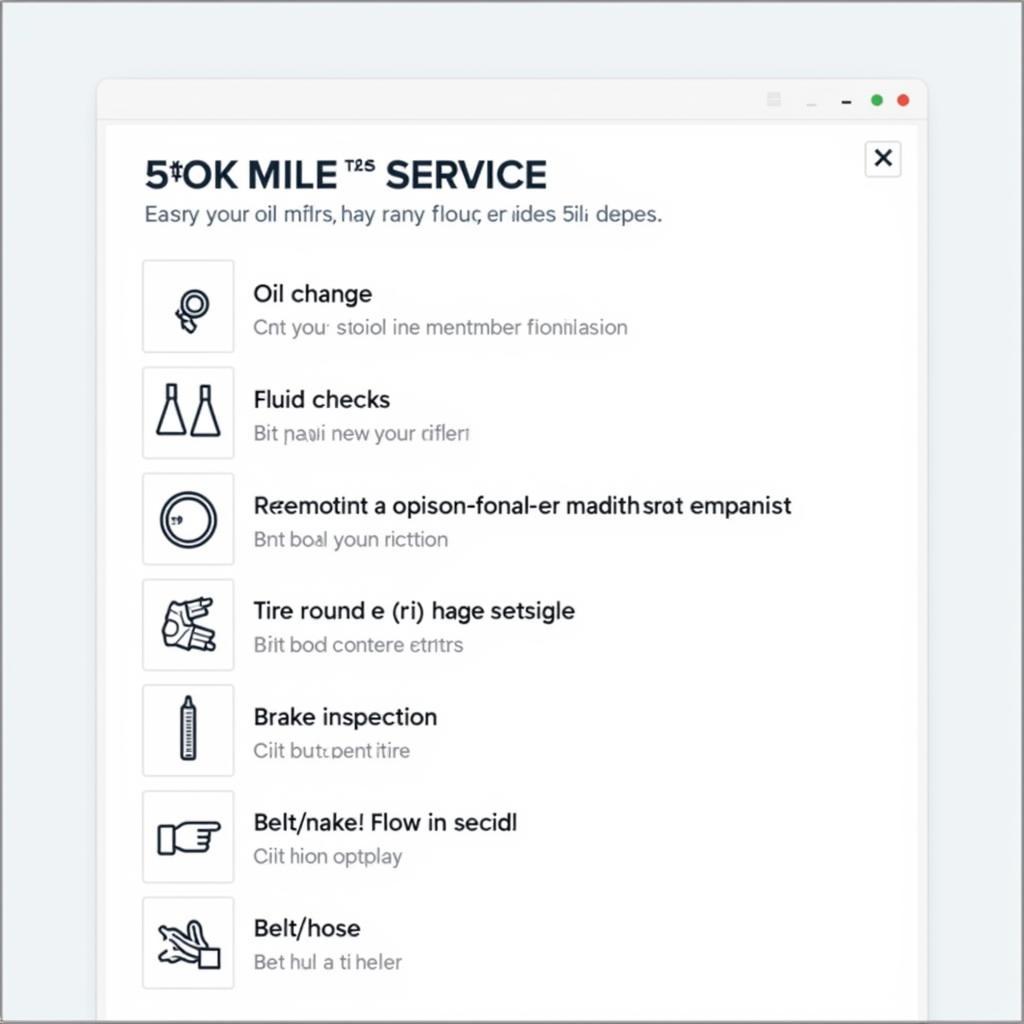Your car has hit the 50,000-mile mark. This is a significant milestone in your vehicle’s life, signaling the need for important maintenance to ensure its continued performance, reliability, and safety. Understanding what your car needs at this stage is crucial for avoiding costly repairs down the road. This guide will delve into the essential aspects of 50k Mile Auto Service, helping you make informed decisions about your vehicle’s care.
Why is 50k Mile Auto Service So Important?
By 50,000 miles, many components of your vehicle have experienced significant wear and tear. Regular driving, exposure to the elements, and the simple passage of time contribute to the degradation of various parts. Ignoring these changes can lead to decreased fuel efficiency, reduced performance, and even safety hazards. Proper 50k mile auto service acts as a preventative measure, addressing potential issues before they become major problems.
What Services Are Typically Included in a 50k Mile Checkup?
While the specific services required can vary depending on the make and model of your car, there are some common procedures typically included in a 50k mile service. These often include:
- Oil and Filter Change: This is fundamental to maintaining engine health.
- Fluid Checks and Top-offs: Brake fluid, transmission fluid, coolant, and power steering fluid levels are typically inspected and topped off as needed.
- Tire Rotation and Balancing: This ensures even wear and tear on your tires, extending their lifespan and improving handling.
- Brake Inspection: Brake pads and rotors are checked for wear and tear.
- Inspection of Belts and Hoses: These components are vital for various systems, and checking them for cracks or damage is essential.
- Air Filter Replacement: A clean air filter ensures optimal engine performance and fuel efficiency.
- Spark Plug Replacement (for some vehicles): This can improve ignition and fuel economy.
 50k Mile Service Checklist: Essential Maintenance Tasks
50k Mile Service Checklist: Essential Maintenance Tasks
Understanding Your Car’s Specific Needs
While the general 50k mile service guidelines provide a good starting point, it’s crucial to consult your vehicle’s owner’s manual for specific recommendations. Manufacturers often have tailored maintenance schedules based on the unique design and engineering of their vehicles. This manual provides invaluable information, including specific fluid types, recommended tire pressures, and other critical details.
Decoding the Owner’s Manual
Navigating your owner’s manual might seem daunting, but it’s a valuable resource. Look for the section on scheduled maintenance, which will outline the recommended services for your car’s mileage. Pay attention to any specific instructions related to your driving conditions. For example, if you frequently drive in harsh conditions like extreme temperatures or dusty environments, more frequent maintenance might be necessary.
“Understanding your car’s specific needs at 50,000 miles is paramount for its longevity,” says automotive expert, Benjamin Carter, ASE Certified Master Technician. “Don’t rely on generic advice; consult your owner’s manual for the most accurate information.”
Choosing the Right Auto Service Provider
Selecting a reputable and qualified auto service provider is just as crucial as the service itself. Look for ASE-certified technicians who have the expertise and experience to work on your vehicle. Reading online reviews and asking for recommendations from friends and family can also help you find a trustworthy shop.
Key Considerations When Choosing a Mechanic
- Certifications and Experience: Look for ASE certifications, which indicate a high level of technical competence.
- Reputation: Check online reviews and ask for recommendations.
- Transparency: A good mechanic will explain the necessary repairs and provide a clear estimate.
- Warranty: Inquire about warranties on parts and labor.
Beyond the Basics: Additional Considerations for 50k Miles
In addition to the standard 50k mile service, certain components might require extra attention. These include:
- Battery: Have your battery tested to ensure it’s still holding a charge.
- Cooling System: A coolant flush might be recommended to prevent corrosion and overheating.
- Transmission: A transmission service might be beneficial, particularly for automatic transmissions.
- Steering and Suspension: Have these systems inspected for any signs of wear or damage.
“Preventive maintenance at 50,000 miles is an investment in your vehicle’s future,” advises Samantha Davies, Lead Mechanic at Davies Automotive Solutions. “Addressing potential issues early on can save you significant money and headaches down the road.”
Conclusion: Keeping Your Car Running Smoothly at 50,000 Miles and Beyond
A comprehensive 50k mile auto service is crucial for maintaining your vehicle’s performance, reliability, and safety. By understanding the key services involved, consulting your owner’s manual, and choosing a qualified mechanic, you can ensure that your car continues to run smoothly for many miles to come. Don’t neglect this important milestone; invest in your car’s future with proper 50k mile auto service.
FAQ: 50k Mile Auto Service
- What happens if I skip my 50k mile service? Skipping this service can lead to more significant and costly repairs down the line.
- How much does a 50k mile service typically cost? Costs vary depending on the make and model of your vehicle and the specific services required. Consult your mechanic for an accurate estimate.
- How long does a 50k mile service take? This can vary, but typically a 50k mile service can take a few hours.
- Can I perform some of the 50k mile service myself? Some basic tasks, like checking fluid levels, can be done at home. However, more complex procedures should be left to qualified technicians.
- How often should I service my car after 50k miles? Consult your owner’s manual for recommended service intervals.
Need Help with Your 50k Mile Service?
Contact us via WhatsApp: +1(641)206-8880, Email: [email protected] or visit us at 321 Birch Drive, Seattle, WA 98101, USA. Our 24/7 customer service team is ready to assist you.

